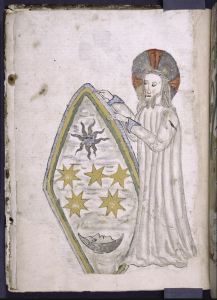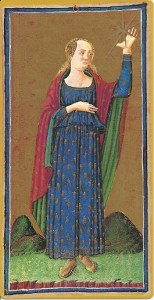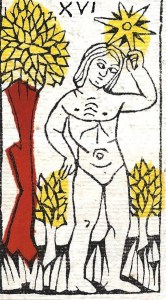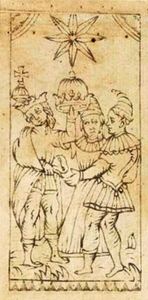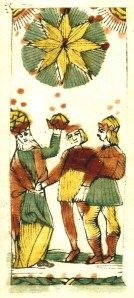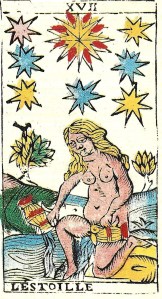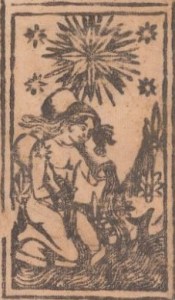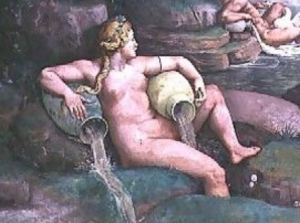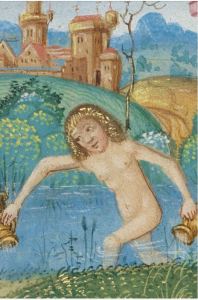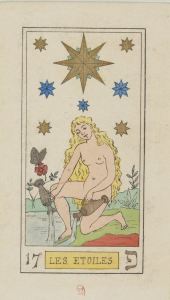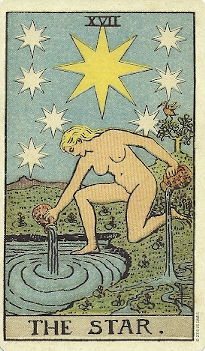La Stella/L’Etoile/The Star
From medieval astronomers to a naked woman pouring water into a pool, the Star card displays a wide range of images. Does the card illustrate a Bible story, an Egyptian myth, or a zodiac constellation? There seems to be no consensus, and no story we can point to as the original interpretation of the card. This frees us to project our favorite myths onto the Star image. Let’s take a look at the most popular interpretations of this enigmatic card.
Early Italian and French Star Cards
This hand painted d’Este card from the mid-15th century combines two popular themes: People pointing up to the sky, and astronomers/astrologers with their measuring instruments. The pointed hat worn by the man on the left tells us he’s an exotic foreigner, possibly one of the three Magi looking up in wonder at the star of Bethlehem.
This magi from the Minchiate deck follows the eight-pointed star of Bethlehem, while bearing gifts in a gold chalice. Minchiate is an expanded tarot deck with twenty extra cards and several redesigned trumps. The deck may have been invented as early as the 1460s, so it’s possible the star of Bethlehem was one of the earliest associations with this tarot card.
Both the hand-painted Visconti-Sforza Star card, and the block-printed Budapest card, show a person reaching up to seize a star. Unfortunately, there are no clues to tell us who they are or why they are reaching for a star. Perhaps the image is a simplified rendering of astronomers or magi; or it could illustrate a story that is lost to us.
When Tarot migrated to France in the 16th century, an astronomer/astrologer appeared most often on the Star card. In the Anonymous Tarot de Paris on the left, an astronomer/astrologer sits at his writing desk holding calipers up to the sky. The Vievil astronomer sits in front of a tower holding calipers. This is the standard Star image in the Rouën-Brussels tarot pattern of the 17th and 18th centuries.
Notice the different number of rays in the large star, as well as the variable number of smaller stars. Planets and stars were depicted with varying numbers of rays in medieval and Renaissance astrological treatises. There was no consistency, and there doesn’t seem to be any symbolism attached to the number of rays.
This enigmatic, three-person scene is specific to the Bolognese tarot tradition. The Rothschild Sheet on the left, printed about 1500, shows a crowned man with an emperor’s orb floating above his head. He holds up a large crown, and seems to be handing something off to the man on the right. Both men wear peaked caps, similar to the d’Este astronomers. These may be Phrygian caps, signifying that the men are astrologers or magi from the mysterious east. The man on the right is dressed like the Bagatto in many Italian decks. The person in the center wearing a gown might be a woman, but the cloth cap is not typical women’s attire.
In the Bolognese Tarocchino, the man on the left wearing a papal tiara is about to put a crown on the head of the man in the middle, while shaking hands with him. The man on the right already wears a crown. This scene is difficult to decipher. The Magi who followed the star of Bethlehem were often called the Three Kings, so this may be a conflation of magi and kings.
Perhaps the man with the papal crown in the Bolognese card above is holding out the promise of a reward in heaven. A few passages in the New Testament refer to a crown when describing the rewards obedient Christians receive in heaven (1 Peter 5:4, 1 Thessalonians 2:19). The theological virtue of Hope (Spes) was traditionally depicted as a woman praying to a crown floating in the sky, or sometimes reaching for the crown. This image by Giotto shows a woman floating up to reach a crown held by an angel. This tarot scene with a crown held up high might explain why “hope” is a traditional interpretation of the Star card.
In the seventeenth century, the Tarot de Marseille design gave the world an entirely new Star card. This image was adopted by French and British occultists, then by A. E. Waite and P. C. Smith for their massively influential 1909 deck. The Star card is now almost universally identified with the Tarot de Marseille image.
The top portion of the card is filled with one large star surrounded by seven smaller stars, all with eight points. Below, a naked woman kneels on the bank of a river or pool with one foot in the water. She pours water from two jars, one stream into the water, and the other onto the earth. A bird perches on a tree behind her.
The Cary Sheet, presumed to be printed about 1500, is possibly a precursor to the Tarot de Marseille. A kneeling figure pours water from two jars into a body of water. There is some controversy over whether the figure is male or female. An eight-pointed star blazes overhead, surrounded by four smaller stars. The star at the figure’s shoulder seems to be sitting at the top of a wand the figure is holding.
There are not many examples of naked women pouring water from two jars in 15th– or 16th-century art. One striking example is this Naiad depicted in a fresco on the walls of the Duke of Mantova’s pleasure palace, Palazzo Te. Naiads are nymphs from Greek mythology associated with pools and streams of fresh water. In Renaissance art they occasionally appear in in the context of pagan scenes.
Over the centuries, numerous explanations have emerged to account for a naked woman pouring water into water while kneeling under a blazing star. These interpretations range from astronomy, to classical and Egyptian mythology, and to the Bible. Let’s look at some of the most plausible theories.
Astronomy and the Star Card
The zodiac sign Aquarius is the most obvious astrological association with this card. Aquarius is usually rendered as a man pouring water from one jar; but it’s not uncommon to see variations such as a woman pouring water from two jars, as in this illustration from a hand-painted calendar. The time of Aquarius is from late January to late February. Calendars that illustrate activities for each month always show winter scenes for Aquarius. It’s doubtful the deck designer was thinking of winter when he illustrated the card. Besides, inserting zodiac signs into the trump sequence seems rather arbitrary and difficult to explain.
Another constellation associated with this card is Pleiades, the seven water nymphs who were the daughters of the titan Atlas. According to one story, Orion pursued them relentlessly until Artemis turned them into seven doves, then seven stars. The bird in the tree on the Star card might be a reference to their time as doves. The central, eighth star is logically their father Atlas, a titan who made war against the Olympian gods. Zeus condemned Atlas to stand at the western end of the earth and hold up the sky. There’s a problem with this attribution: Atlas is not a star, he’s a mythic figure who is usually depicted bent over from the weight of holding up the celestial globe.
The Star card might be a stand-in for the sphere of stars that sits beyond the planetary spheres in the geocentric version of the cosmos. But the card is in the wrong position in the trump sequence for this. The Star card should be after the Moon and Sun cards if these cards are meant to illustrate the geocentric cosmos.
An eight-pointed star has been associated with the goddess of love ever since the Mesopotamians used this star as a symbol for their goddess Inanna/Ishtar. But a survey of astrological illustrations from the 14th through 16th centuries reveals that all the planets were depicted with anywhere from six to twelve rays. There is no strong correlation in European art between the planet Venus and an eight-pointed star. In this 16th century engraving, Venus is shown with the symbols for Taurus and Libra, the zodiac signs she rules, and with a six-pointed star over her head. There are a few other problems with seeing this card as Venus. The mythic Venus/Aphrodite is rarely depicted pouring water. If the central star is Venus, and the other stars are also planets, then there is one star too many.
We need to ask why a constellation or planet was put in this position in the trump sequence, and if it makes sense in the context of the other cards. Free associating on the details of one card often leads to conclusions that don’t hold up when you stand back and look at the entire series of trumps.
Biblical Associations with the Star Card
As we saw in the article about the Star-Moon-Sun series, these cards form a bridge in the trump sequence between Hell and Paradise. The entire sequence of trumps, starting with the Devil card, might illustrates the Apocalypse as described in the book of Revelation in the Bible. Revelation begins and ends with imagery related to the Star card.
In the first chapter of Revelation, the author, John of Patmos, hears a voice like a trumpet behind him commanding him to write down what he will see in his visions and send it to the seven churches of Asia (Roman provinces in Asia Minor). When John turned around, he saw a man who is obviously Christ, although he isn’t named. This man is surrounded by seven golden candlesticks and he holds seven stars in his hand. In verse 20, Christ explains that the seven candlesticks are the seven churches, and the stars are the seven angels (messengers) of the churches. This scene kicks off a series of visions about the end of time where the stars, the moon and the sun are mentioned numerous times.
The last chapter of the book (Revelation 22:1-2) continues John’s visions. “And he showed me a pure river of water of life, clear as crystal…and on each side of the river, was there the tree of life…” Further on, in verse 16, Jesus says, “I am the root and offspring of David, and the bright and morning star.”
None of this explains the presence of a naked woman pouring water into a pool. The French occultists, with their theories about tarot’s Egyptian origins, are the first to address this issue directly.
The Occult/Egyptian Star Card
The woman pouring water in the Star card is very likely a combination of several ancient goddesses. In Mesopotamia, the eight-pointed star symbolized the goddess Inanna/Ishtar (shown here), who was later associated with the classical goddess Aphrodite/Venus. In Egypt, the goddess Sothis was associated with the star Sirius, which rose in the east at dawn at the time of the annual Nile flood. The Greeks later conflated Sothis and Isis. The Nile has two headwaters, the White Nile and the Blue Nile. It’s possible the designer of the Tarot de Marseille depicted Sothis/Isis starting the annual flood by pouring water into the Nile, while the star of Aphrodite shines overhead. The annual flood of the Nile connects this card to the Moon and Sun cards, as discussed in the Celestial Lights article. French and British occultists stated explicitly that the woman is Isis and the large star is Sirius. But they also saw the star as Venus, as she is an important symbol in Masonic rituals.
Occultists interpreted this card through multiple lenses: Egyptian, alchemical, Masonic, and Kabbalistic. They saw the Star woman as a transformed Temperance angel pouring her elixir onto the earth. Burning liquid pours from the gold jar to revivify stagnant water; while from the silver jar flows pure water that nourishes the natural world. Some occultists, like Oswald Wirth, changed the bird into a butterfly, representing Psyche, the resurrected immortal soul. The stars guide us toward fulfilling our innate destiny. In Wirth’s deck, the butterfly perches on a rose, an Egyptian symbol related to the goddess Isis, who became the Greek/Roman goddess of love, Aphrodite/Venus. The rose and butterfly together may represent the story of Eros and Psyche. An Acacia branch sits on the right side of Wirth’s Star card. Acacia is an evergreen tree that represents immortality. In the French occult tradition, this card is associated with the Hebrew letter Phe, connecting it to the planet Mercury with its correlation to speech and communication. In this context, the bird that perches on a tree in the Tarot of Marseille card could be interpreted as a messenger from Heaven.
The British Hermetic Order of the Golden Dawn named this card The Daughter of the Firmament, and illustrated it with seven-pointed stars. Their correlation of the card with the Hebrew letter Tzaddi aligns the Star with Aquarius. The Golden Dawn’s understanding of this card was more internal, teaching the value of quiet contemplation and listening to one’s inner voice.
Although both Waite and Smith were former Golden Dawn members, they reverted to the French eight-pointed stars when designing this card. Waite’s symbolism draws on the same sources as French occultists—Masonic, Kabbalistic and Egyptian, but with Waite’s personal emphasis. An Ibis, symbol of Thoth, sits on an acacia, the tree that marks the tomb of the builder of Solomon’s temple. Although Waite says the woman pouring out the waters of life represents eternal youth and beauty, he also says that, above all, she is the Kabbalistic Great Mother of Binah.
Interpreting the Star Card
Whether the card depicts medieval astronomers or a naked goddess, its interpretation has remained remarkably unchanged over the years. “Gift” is the oldest known divinatory meaning for this card, recorded in Bologna about 1750. This is probably a reference to the gifts carried by the three Magi as they followed the star of Bethlehem to the Christ child.
For Christians, the star of Bethlehem announces the birth of Christ and the hope of overcoming death. “Hope” is a common interpretation of this card. One or more people looking up in amazement and wonder at an abnormally bright star is the most popular rendition of this card. On many early tarot Star cards, people reach for the star, hoping for healing, blessings, or an omen. Who hasn’t wished upon a star at one time? A bright star alone in the sky invites us to pin our hopes on it. The card promises that our wishes will come true and our hopes will be fulfilled. Coming immediately after the pain and chaos of the Tower, this card gives assurance that the storm is over and life will fall into a new and better pattern.
The Tarot de Marseille and Waite Smith image brings in another set of interpretations. The woman has nothing to hide—we can trust her to give us the naked truth. She exists in a state of innocence, like Eve in the Garden of Eden before eating the apple. Her soul is pure and innocent, and she approaches life with trust and simplicity. The act of pouring water could be a libation offered to the spirits of the land, or a personal ritual of purification. She nurtures life and pours blessings on the earth.
In the Tarot de Marseille, a small star hovers directly over the woman’s head, with the largest star immediately above it. Divine energy and blessings flow from the source in the large star, through the individual’s higher self, embodied in the small star, then into the physical body and out into the world as healing energy, divinely inspired guidance, or altruistic compassion.
The problematic aspect of this card is being unable to receive the blessings of the card, or blocking the guidance the universe is trying to send you. It can also indicate being too exposed and vulnerable, or being dangerously naïve.
Contemporary Star Cards
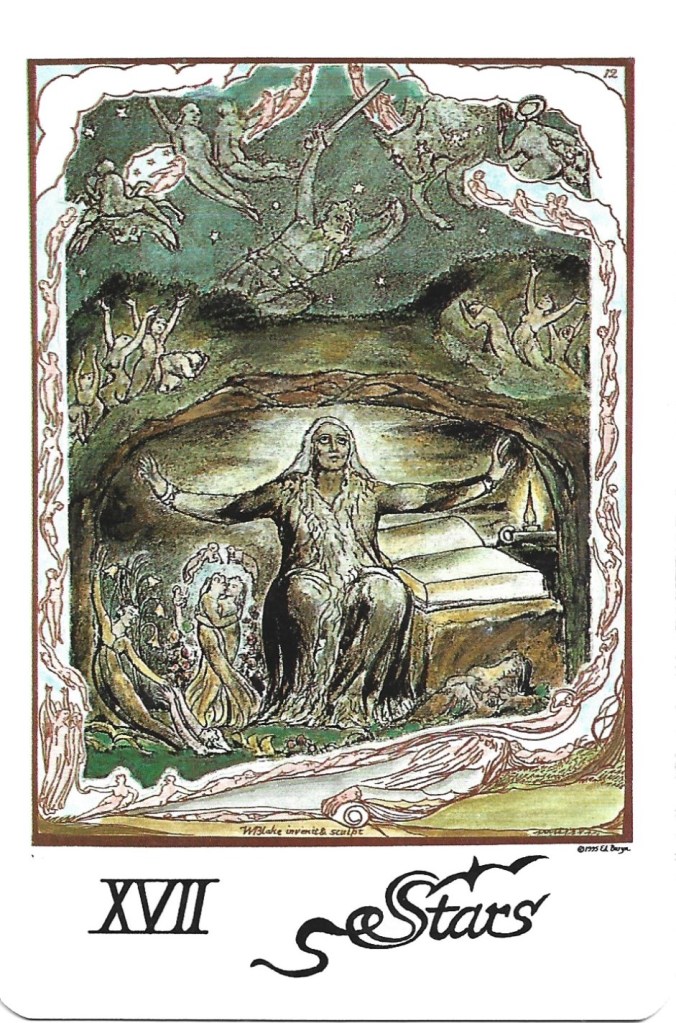
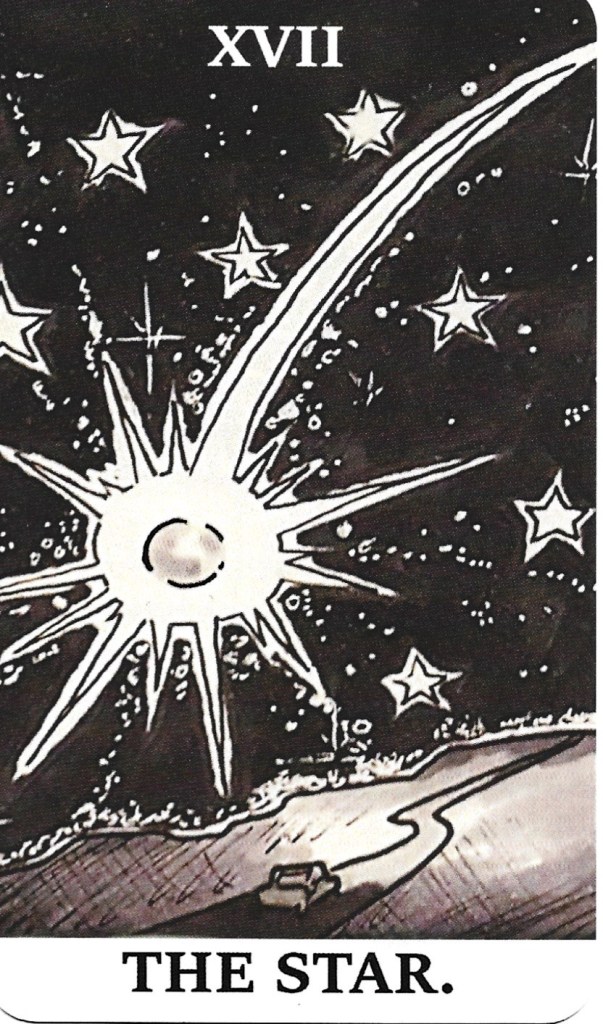
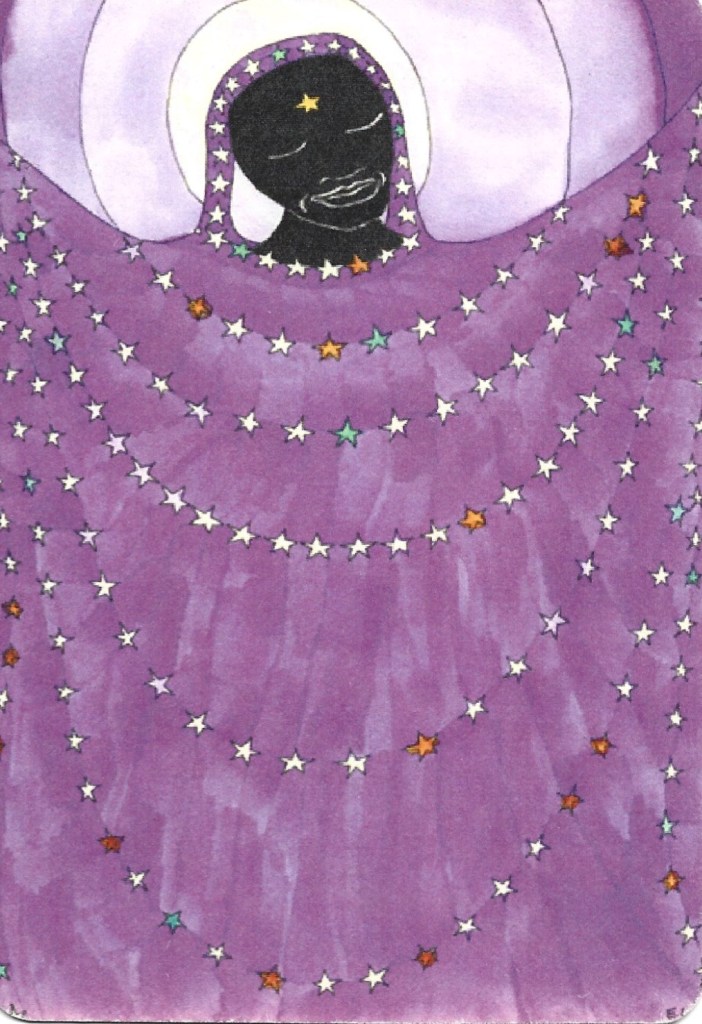
It’s not easy to find cards that break the mold of a naked woman pouring water. Here are a few examples.
The William Blake Tarot shows the blind poet John Milton in an underground grotto, his arms outstretched to receive cosmic energy. The card illustrates the final verse of his poem Il Penseroso, where he asks to spend his old age in a hermitage communing with the stars and the spirits of plants. The figure at bottom left is the spirit of flowers, with a couple symbolizing perfect love next to her. In the sky we find the constellations Gemini, Orion and Taurus. On the right, the flame of intellect sits next to a blank book that’s open to receive the poems Milton will write as divine inspiration flows through him.
In the Ink Witch Tarot, a blazing comet overwhelms a solitary automobile on a lonely country road. Celestial omens aren’t always gentle and uplifting; they can rock your world in a terrifying manner.
The Tarot of the Crone presents us with the Queen of the Night spreading the starry cosmos like a net. The night sky holds the constellations that embody our mythology, and the fixed stars that guide our destiny. They are the intermediaries between our human lives and transcendent reality.
See more cards and art at TarotWheel.net
https://www.tarotwheel.net/history/the%20individual%20trump%20cards/la%20stella.html
Read the Introductory article on the Star, Moon and Sun cards here.
List of images
God Creating the Stars. Illustrated German manuscript, 1445. Collection of the New York Public Library.
Ercole d’Este Tarot. Florence/Ferrara mid-15th century. Collection of the Beinecke Library, Yale University, New Haven, Connecticut.
Tarot Minchiate al Leone di Girolamo. Bologna c. 1700. Facsimile by Amparo Aguirre, 2022.
I Tarocchi Visconti Sforza. Milan c.1450. Reproduced by Il Meneghello, Milan, 2002. Collection of Pierpont Morgan Library, New York City.
Budapest Tarot, late 15th century. Recreated by Sullivan Hismans, Tarot Sheet Revival, 2017. Collection of the Museum of Fine Arts, Budapest and the Metropolitan Museum of Art, New York City.
Tarot de Paris, c. 1650. Facsimile by André Dimanche/Grimaud, 1980. Collection of Bibliothèque Nationale Française, Paris.
Tarot de Jacques Vieville. Paris, mid-17th century. Collection of the Bibliothèque Nationale Française.
Vandenborre Tarot. Brussels, mid-18th century.
Rothschild Sheet, c. 1500. Collection of Edmond de Rothschilde, the Louvre, Paris.
Tarocco Bolognese Al Mondo, 1725. Facsimile by Marco Benedetti, Rome, 2020. Collection of The British Museum
Spes. Giotto, 1303. Scrovegni Chapel, Padua.
Jean-Pierre Laurent Tarot. Belfort, 1735. Restored by Yves Reynaud, 2020
Jean Payen Tarot de Marseille. Avignon, 1743. Facsimile produced by Marco Cesare Benedetti, 2023.
Cary Sheet. Yale University, New Haven, CT. (Kaplan II p. 286-7)
The Rustic Banquet, 1528. Julio Romano, fresco Sala de Gigante, Palazzo Te.
Month of January (Aquarius). Illuminated manuscript. Collection of the Getty Museum, Los Angeles.
Venus. Engraving, 16th century.
Ishtar. Mesopotamian cylinder seal impression. Bronze Age.
Oswald Wirth Tarot, 1887. Collection of the Bibliothèque Nationale Française, Paris.
The Golden Dawn Tarot. Robert Wang and Israel Regardie. U.S. Games, Systems Inc., Stamford, CT, 1977.
The Centennial Waite Smith Tarot Deck. London, 1909. U.S. Games System, Inc., Stamford, CT, 2009.
William Blake Tarot. Ed Buryn. Thorsons, 1995
Ink Witch Tarot. Eric Maille. Self-published, 2021.
Tarot of the Crone. Ellen Lorenzi-Prince. Self published, 2002.
Bibliography
Michael Howard on the Egyptian connection
See the separate Bibliography for books that discuss all the trump cards.

